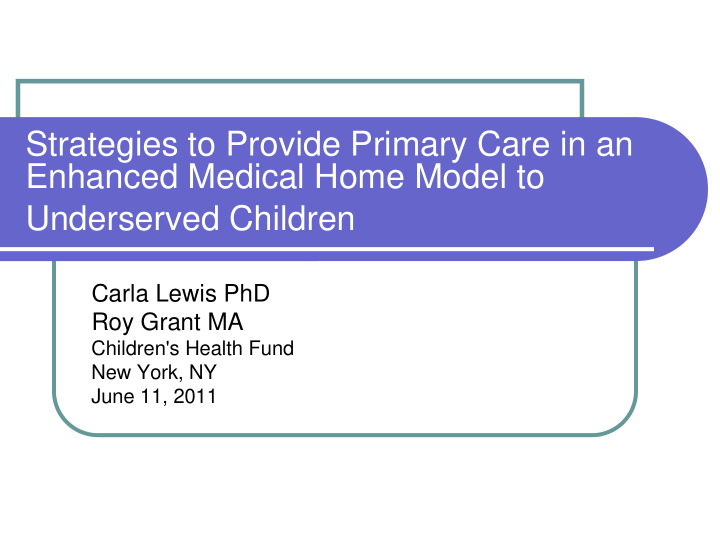



Strategies to Provide Primary Care in an Enhanced Medical Home Model to Underserved Children Carla Lewis PhD Roy Grant MA Children's Health Fund New York, NY June 11, 2011
Enhanced medical home model Primary care that is Readily accessible Continuous Comprehensive Coordinated Family-centered Culturally competent American Academy of Pediatrics, Pediatrics. 2004 Enhanced medical home model integrates mental health and oral health care, and facilitates access to other specialists Brito et al. Advances in Pediatrics. 2008
Having a pediatric medical home is associated with..... Improved health status Lower health care costs Reduced health disparities Starfield & Shi. Pediatrics. 2004 Improved management of chronic conditions Improved care coordination for children with complex health care needs Palfrey, et al. Pediatrics. 2004.
Special needs of medically underserved children High rate of psychosocial problems and toxic stress exposures Domestic violence Maternal depression Unstable housing and homelessness Foster care and kinship households Evans & English. Child Development. 2002. Higher prevalence of chronic disease and emotional/behavioral problems Shonkoff, Boyce, McEwen. JAMA. 2009.
Enhanced medical home in practice More time per patient than typical pediatric visit Focus on alleviating access barriers Integration of specialist services Developmental screening & surveillance Mental health screening and treatment Oral health care Tracking referral outcomes Health education Effective use of health information technology Evidence-based/informed protocols
Setting: Children’s Health Fund (CHF) National Network Network of 23 projects in 16 states serving inner city & rural poor, homeless, migrant, immigrant, and post-disaster pediatric populations Fleet of >50 mobile clinics providing medical, mental heath and oral health care Each project affiliated with an academic or children’s hospital, or (in rural areas) a federally qualified health center Nearly half provided care at schools
Study design Two surveys of national network describing scope of practice in each project Responses from medical directors and program administrators Follow-up phone calls for clarification 100% response rate
Results: exceeding AAP medical home standards 80% provided mental health 100% saw patients regardless of screening and treatment ability to pay ____________________________________ __________________________________________ 79% dispensed prescription and 100% maintained 24 hour / 7 day per over-the-counter medications week coverage by affiliation with ____________________________________ academic medical centers or federally qualified health centers 63% provided nutrition counseling ________________________________ ____________________________________ 95% saw walk-ins with same-day appointments 57% used electronic health records ___________________________________________ ____________________________________ 84% had formalized systems to track 42% supplemented oral health referrals and facilitate care screening with fluoride varnish coordination
In 2010, CHF national network projects provided 130,520 medical encounters 38,467 mental health and case management encounters 9,820 oral health encounters 8,884 nutrition encounters 56,687 health education encounters 33,720 community outreach encounters 2.25 million encounters since 1987
Asthma education materials: Highly visual, bi-lingual
Value of integrating evidence-based asthma care (% of pts with asthma) 61.3% 60.0% 40.0% Baseline 28.6% Follow-up 19.4% 20.0% 2.2% 0.0% Hospital ED Use
Savings to the health care system • Reduced ED visits @ $500 average cost • Reduced hospitalizations @ $7,000 average cost • Reduced cost per medically underserved inner-city pediatric patient with asthma per year = $4,525 Calculation based on reduced percentage of hospital/ED • users and reduced mean number of hospitalizations/ED visits per user at baseline compared to follow-up. Cost-of-illness economic model used with 2004 dollars not further adjusted for health care inflation. Grant, Bowen, Neidell, Prinz, Redlener. J Health Care for Poor & Underserved. 2010 •
Impact of care coordination: Access to specialists 60% 60% Services included: 50% Reminders 40% Transportation Facilitate scheduling 30% Navigational assistance at point 20% of service 7% 10% 0% baseline follow-up Redlener, Grant & Krol. Advances in Pediatrics. 2005 .
Conclusions First requirement of medical home: timely access to comprehensive services Alternative care models provide an enhanced medical home Mobile medical clinics School-based and school-linked clinics Quality and continuity of care are not compromised Essential to maintain clinical and community linkages Cost-effectiveness of pediatric medical home model has been established -- for children with asthma Willson CF. N C Medical Journal . 2005.
References American Academy of Pediatrics. Policy statement: Organizational principles to guide and define the child health care system and/or improve the health of all children. Pediatrics . 2004; 113: 1545-1547. Brito A, Grant R, Overholt S, Aysola J, Pino I, Spalding SH, Prinz T, Redlener I. The enhanced medical home: The pediatric standard of care for medically underserved children. Advances in Pediatrics . 2008; 55: 9–28. Starfield B, Shi L. The medical home, access to care, and insurance: a review of evidence. Pediatrics . 2004; 113(5 Suppl):1493-1498. Palfrey JS, Sofis LA, Davidson EJ, Liu J, Freeman L, Ganz ML The Pediatric Alliance for Coordinated Care: evaluation of a medical home model. Pediatrics . 2004;13(5 Suppl):1507- 1516. Evans GW & English K. The environment of poverty: Multiple stressor exposure, psychophysiological stress, and socioemotional adjustment. Child Development. , 2002: 73: 1238–1248. Shonkoff JP, Boyce WT, McEwen BS. Neuroscience, molecular biology, and the childhood roots of health disparities: building a new framework for health promotion and disease prevention. JAMA . 2009; 301(21): 2252-2259. Grant R, Bowen SK, Neidell M, Prinz T, Redlener IE. Health care savings attributable to integrating guidelines-based asthma care in the pediatric medical home. Journal of Healthcare for the Poor & Underserved . 2010; 21(Suppl 2): 82-92. Redlener I, Grant R, Krol D. Beyond primary care: Ensuring access to subspecialists, special services and health care systems for medically underserved children. Advances in Pediatrics . 2005; 52: 9-22. Willson CF. Community Care of North Carolina: Saving state money and improving patient care. North Carolina Medical Journal . 2005; 66: 229-233.
Recommend
More recommend